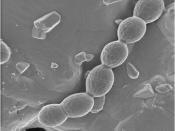Many persons are oblivious to the fact that when they consume certain delicious food products like yogurt, buttermilk or cheese, they are actually eating live bacterial biomass which has acidified the milk content and contains a mixture of bacterial slime layers. Perhaps it is a blessing that most people are unaware because when most hear the word 'bacteria,' their first thought is of a microscopic unicellular organism that causes various types of diseases especially if it is found in food. This may be true for most micro organisms, but there are some bacterial species that are essential in the manufacture of those tasty foods, (Johnson-Green, 2002). One such group of bacteria is the Lactic Acid Bacteria (LAB). Kun (2003) has found that it has become increasingly difficult to define this set of organisms as most opinions differ as to which organisms should be a part of this group. However, they can be broadly defined as a large group of related bacteria that have similar properties and convert carbohydrates to lactic acid by lactic acid fermentation.
They are heterotrophic and can be found extensively in nature including plant leaves (e.g. Lactobacillus, Leuconostoc), the animal's oral cavity (e.g. Streptococcus mutans), digestive system (e.g. Enterococcus faecalis), genitourinary tract (e.g. Lactobacillus) as well as faecal matter, compost and rotting vegetation. These areas normally have an adequate supply of amino acids and vitamins (Murray et al, 1998; internet 1). They are aero tolerant anaerobes which mean they can tolerate oxygen but do not use it, (Johnson- Green, 2002).
The group consist of a number of gram positive bacteria which include the genera; Aerococcus, Bifidobacterium, Carnobacterium, Enterococcus, Lactococcus, Lactobacillus, Lactosphaera, Leuconostoc, Microbacterium, Oenococcus, Pediococcus, Streptococcus, Tetragenococcus, Vagococcus and Weissella, (Jay, 2000). They can be categorized into two groups based on the amount of lactic acid produced...


